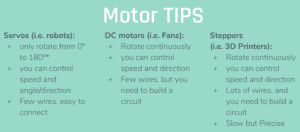1. Drawing Machine
With You Xu.

The form summarizes well the three crucial kinds of motors. One notable tip is that with the use of high volt power, it’s important to take measures to prevent current from flowing reverse.

H bridge is divided to 4 parts.
Arduino sends signal to control current direction, from H bridge terminal 1, 2, 3, 4A.
Ground is a must, from GRN1, 2, 3, 4.
Output to motor through 1, 2, 3, 4Y.
VCC1, 2 are both powers for motor.
EN is to enable 1, 2, 3, 4A to transmit signal.

That’s the connection according to scheme. Before plugging in, 5v power from mac can already make the motor spin, because VCC permits power but weak. And then the it’s the recording of the drawing machine.
2. Answers to Questions
1) What kind of machines would you be interested in building?Add a reflection about the use of actuators, the digital manipulation of art, and the creative process to your blog post.
I am interested in making things move, like the mechanical mirror. In the past, we find computer screens the virtual world a dynamic painting. Now, we can make the reality a dynamic painting, since there’re actuators.
2) Choose an art installation mentioned in the reading ART + Science NOW, Stephen Wilson (Kinetics chapter). Post your thoughts about it and make a comparison with the work you did during this recitation. How do you think that the artist selected those specific actuators for his project?
I like Douglas Repetto’s Giant Painting Machine, 2006. It’s almost the same as this time’s, but it’s huge. The most common way to paint by machine is to print. But this project imitates human drawing. Thus it’s a really pretentious way of painting. For accuracy, a step motor is most liked used.